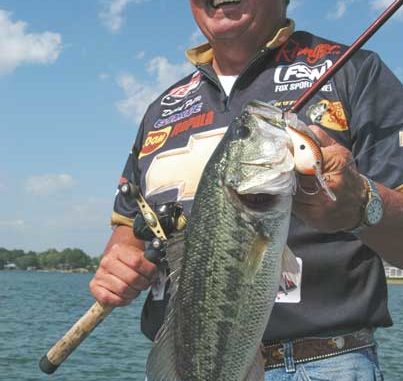
I love to go deer hunting in November, and the way our lakes are drying up across North Carolina, that may be my only option.
But bass fishing can be excellent, provided you can find a lake with enough water left to launch your bass boat. And you’ll find the lower water levels can really make for better fishing than if the water was at a higher level. You’ll just have to be a little more careful running.
In November, you’ve got some fish that are still biting in the backs of creeks, but bass will be more concentrated at the main parts of the creeks. The fishing is almost like late February or early March.
Bass can be in extremely shallow water, but they’ll also be close to deep water. The best patterns will have your boat in 20 feet of water while you cast to the bank.
Some of the best days I’ve ever had at Buggs Island were fishing bluff walls; that’s the kind of stuff they like to get on. I was in 30 feet of water, and the fish were shallow but close to deep water. And the steeper the bank, the better, especially if it featured rocks.
Rip-rap gets real good in November, especially the corners.
November is a good month to fish a crankbait because you’re going to be having to cover a lot of water. I like to fish a Rapala DT-10, a DT-6 or a DT Flat 7. You’re not going to need to fish much deeper than these baits will run.
Color can be a key, especially in the fall when browns and shad shades tend to be important colors. The old “carp” color was always great in the fall. Rapala has a new color — Brown/Bone — that’s much like the carp color. Brown/chartreuse also works well, and plain white or pearl baits (or with black backs) can be excellent (obviously they look like gizzard shads). The old “gray ghost” was always a great color in the fall.
And because you don’t really need to make long casts or get baits down too deep, 10-pound-test Rapala line will be all you need.
One thing I really look for in November is shallow brush.
If you’re fishing a lake like High Rock, Wylie or Norman — good boat-dock lakes — you can be in for some great fishing. There’ll be a lot of brush piles near the ends of docks, especially if the dock is standing on a hard bottom. With the water level down, those brush piles are going to be shallow.
In the fall, those brush piles are going to be full of little crappie — a lot of people are crappie fishing. And if those brush piles are in the right places, there’ll be bass in there, feeding on the little crappie.
The shallower you find the brush, the better, as long as it isn’t actually sticking out of the water. A perfect situation is if you get your crankbait hung up, you can go up and knock it loose with your rod tip.
A brush pile that comes up within 2 or 3 feet of the surface is perfect. And there’ll be a lot of them at High Rock, Wylie and Norman. Those are lakes with a lot of docks and a lot of brush because there are so many crappie fishermen.
The two patterns I like to fish — rocks and brush — can both be even better when lakes are drawn down in the fall, or when we haven’t had any rain and they’re just drying up. Bass don’t have as much cover to get in, so if you can find some, it should hold bass.
At a lake like Buggs Island that doesn’t have many docks, a pattern that can really work is stumps. You’ll find a lot of them right at the edge of the dropoffs into creek channels.
You can have your boat in 10 or 12 feet of water and turn your trolling motor a little one way or the other, and you’re in 4 or 5 feet of water. The stumps you find at those kinds of drops will get you the big bite you really need.
I like to fish them first with a crankbait and then with a jig and Zoom chunk trailer. In the fall, you shouldn’t have any problem with just a crankbait and a jig.
As you get closer to Thanksgiving and the end of the month, you’re going to find more fish moving out toward deep water, out toward the main lake. You can look for the same kinds of shallow brush; your better concentrations of fish are just going to be closer to the mouth of the creek or on the main lake.
It’s good to remember these kinds of things when you’ve run out of big-game tags or gotten tired of sitting in your deer stand — fish shallow close to deep water, rocks and brush, cover a lot of water and you’ll catch a lot of nice fish.
David Fritts is a 50-year-old professional bass fisherman from Lexington. He won the 1993 Bassmasters Classic, was the 1994 Bass Angler of the Year and won the FLW Tour Championship in 1997. He is sponsored by Ranger boats, Evinrude outboards, MinnKota, Zoom, Rapala, Bass Pro Shops, American RodSmiths, Solar Bat and Chevrolet.




Be the first to comment